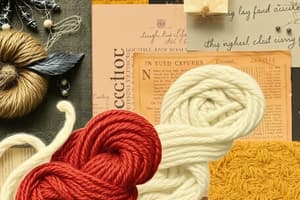Podcast
Questions and Answers
Which fabric is described as very breathable and can withstand wear and washing well?
Which fabric is described as very breathable and can withstand wear and washing well?
- Cotton
- Viscose
- Nylon
- Polyester (correct)
What characteristic is unique to viscose compared to natural fabrics like cotton or wool?
What characteristic is unique to viscose compared to natural fabrics like cotton or wool?
- It drapes beautifully. (correct)
- It is more breathable.
- It is cut easily on the grain.
- It is very warm.
What is a primary difference between clothing needs and wants?
What is a primary difference between clothing needs and wants?
- Wants are necessary for social acceptance.
- Needs are typically more fashionable than wants.
- Needs are essential for survival, while wants are not. (correct)
- Wants are always more affordable than needs.
What challenge is associated with cutting viscose fabric?
What challenge is associated with cutting viscose fabric?
When considering purchases, what is recommended to distinguish between clothing needs and wants?
When considering purchases, what is recommended to distinguish between clothing needs and wants?
Which property of cotton makes it suitable for creating everyday clothes?
Which property of cotton makes it suitable for creating everyday clothes?
What is a common characteristic of wool as a textile fiber?
What is a common characteristic of wool as a textile fiber?
Which textile fiber is known for requiring high-temperature ironing?
Which textile fiber is known for requiring high-temperature ironing?
Which of the following fibers is classified as a synthetic textile?
Which of the following fibers is classified as a synthetic textile?
Why might silk satin be difficult to differentiate from polyester satin?
Why might silk satin be difficult to differentiate from polyester satin?
What issue do linen garments commonly face?
What issue do linen garments commonly face?
Which property of cotton might be problematic if not addressed before use?
Which property of cotton might be problematic if not addressed before use?
What is a characteristic of wool that may make it less appealing to some consumers?
What is a characteristic of wool that may make it less appealing to some consumers?
Flashcards are hidden until you start studying
Study Notes
Definition of Textile
- Textiles are materials created from natural or manufactured fibers, threads, or filaments.
- Constructed by interlocking yarns in specific patterns to produce cloth.
- The manufacturing process involves spinning fibers into yarns, then creating fabric through methods such as weaving, knitting, or felting.
- Properties of textiles are influenced by fiber type, yarn gauge, twist, weave, processing, and finishing.
Types of Textile Fibers
Natural Textiles
- Cotton: Breathable, sturdy, easy care, prone to creasing and shrinking.
- Denim: Durable fabric typically made of cotton.
- Hemp: Strong and eco-friendly, often blended with other fibers.
- Linen: Highly breathable, rustic feel, easily creases, good for summer clothing.
- Silk: Luxurious and warm, with sheen; requires careful cleaning.
- Wool: Warm and drapey, may itch; often requires dry cleaning.
Synthetic Textiles
- Nylon: Resilient and often used in activewear.
- Polyester: Crease-resistant, widely used, less warm than natural fibers.
- Acetate: Glossy fabric often used for linings and formalwear.
- Acrylic: Warm, resembles wool, often used in sweaters.
- Polar fleece: Soft, warm fabric ideal for cold-weather clothing.
- Rayon/Viscose: Semi-synthetic, elegant drape, can be challenging to work with.
Characteristics of Selected Textiles
- Cotton: Crispy texture; versatile for everyday wear; often combined with elastane for stretch.
- Wool: Warmth and quality; typically more expensive; needs lining to prevent itchiness.
- Linen: Better draping than cotton; prone to wrinkles; easier to iron when damp.
- Silk: Luxurious feel with care requirements; needs dry cleaning.
- Polyester: Versatile styles; durable and resistant to creasing.
- Viscose: Beautiful drape; not as breathable as cotton; can be confused with soft cotton or polyester.
Clothing Needs vs. Wants
- Clothing needs: Essential items like pants, shirts, and underwear for societal norms.
- Affordable options available through thrift stores or budget-friendly outlets.
- Clothing wants: Non-essential, often expensive items like designer suits; not necessary for survival.
Studying That Suits You
Use AI to generate personalized quizzes and flashcards to suit your learning preferences.




